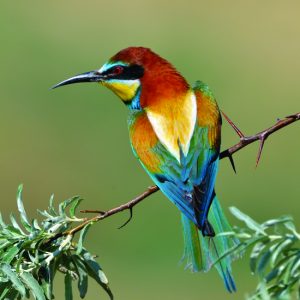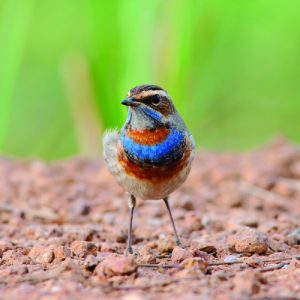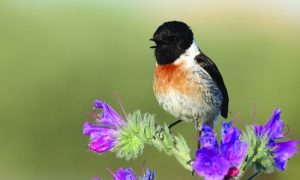×


We have detected your country as:
Please click here to go to the USA website or select another country from the dropdown list.
by: Kathy DeGagné, BFP Staff Writer

European Bee-eater (Mircea BEZERGHEANU/Shutterstock.com)
An electric blue flash—turquoise and sapphire plumage as rich as Joseph’s coat of many colors, against a backdrop of emerald green—signals the flight of a Kingfisher hunting from its perch above the Jordan River.
Spring has arrived in Israel, and with it comes one of the most breathtaking wonders in the natural world. Five hundred million migrating birds take to the skies on an odyssey from their wintering grounds in Africa to their summer breeding grounds in Europe and Asia. Israel lies at the strategic center of this land bridge between Africa and Europe, and the skies over Israel are filled with the sights and sounds of this massive migration every spring and fall. The prophet Jeremiah mentions this age-old phenomenon in the Tanakh (Gen.–Mal.): “Even the stork in the heavens knows her appointed times; and the turtledove, the swift, and the swallow observe the time of their coming” (Jer. 8:7).
Israel is a favored stopover where exhausted birds can recuperate after a grueling 20- to 40-hour flight over the scorching North African Sahara desert. Fruit orchards, vineyards, farmland, desert oases, forests, seacoasts, lakes and streams—Israel offers these wonderfully diverse and attractive habitats for migratory bird species to stop, rest and refuel.
Soaring migratory birds need to avoid large bodies of water in order to take advantage of the warm air currents, called thermals, which give their wings the lift required to navigate thousands of kilometers with less effort. This makes the Rift Valley/Red Sea flyway over countries that border the eastern coast of the Mediterranean and the Red Sea, one of the most important bird migration routes in the world.

Bluethroat (non15/Shutterstock.com)
The entire country of Israel, from Mount Hermon on the northern border to the Aravah in the south, is one big birding site, renowned as one of the prime bird watching centers on the planet. Bird watchers from all over the globe descend upon this tiny strip of land, spring and fall, to view the hundreds of species of birds that pass through Israel’s flight corridor. In addition to the transients, 270 species of birds make Israel their home year-round. All together, over 540 species have been sighted to date.
Israel maintains ten ornithological centers country-wide that provide research, protection, and public education. The Hula Valley in northern Israel is one of the country’s most popular birding sites. Large agricultural fields and marshy wetlands lure thousands of migrating birds down from the skies to feast on the corn, grain and aquatic life. Agamon Hula is a recreational park in the valley that features freshwater lakes, observation points, walking and biking paths, guided tours and birding festivals that educate visitors about the hundreds of bird species that make the valley their home-away-from-home. In the fall migration of 2013, the Hula Valley reported that 1 million raptors, 50,000 White Pelicans, 100,000 Eurasian Cranes and 300,000 Honey Buzzards had landed there by November.
The Jerusalem Bird Observatory, located near the Knesset, tags up to 20,000 birds a year. The Observatory is alerted when one of their banded birds has been caught or dies in another country, and if they find a bird tagged by another country, they return the favor. With this kind of international cooperation, researchers hope to learn more about migration routes, feeding habits and age.
Southern Israel provides avid birders the first spectacular glimpse of waves of migrating birds heading northward over the Aravah Valley. Eilat, Israel’s famous resort city on the Red Sea, offers some of the best bird watching opportunities in the world. This year on March 23–30, Eilat hosted the weeklong 8th Eilat Spring Migration Festival where a sold-out crowd gathered to celebrate this exciting spectacle.
Israel’s first international bird watching competition, “Champions of the Flyway” was held in the Aravah just north of Eilat on April 1, 2014, back-to-back with Eilat’s Spring Migration Festival. Teams were given 24 hours to spot the most number of bird species, with all the profits from this event donated for conservation projects in Europe, Africa, and the Middle East.

Stonechat (raulbaenacasado/Shutterstock.com)
Studies have shown that over 40% of migrating bird species have experienced serious decline over the last 30 years. The use of pesticides in agricultural fields below the Rift Valley/Red Sea flight corridor poses a severe threat as birds descend to feed. Collision with power lines and wind turbines located along flight paths also seriously impact migrating birds. Birds soaring on the thermals have the potential to bring down large aircraft—ten Israeli Air Force fighter jets have already collided with flocks of birds, killing three pilots—necessitating the installation of several bird radar stations to prevent future strikes.

Red-rumped Swallow (raulbaenacasado/Shutterstock.com)
Conservationists are also working to reduce illegal hunting and indiscriminate trapping, primarily in Lebanon, Syria and Jordan. Hunters in Egypt and Libya set up nets along stretches of the Mediterranean coast to trap the Common Quail, but other species are impacted as well and millions of birds are killed every year, some of which are on the endangered list.
Conservation projects, conducted across borders in the Middle East, attempt to deal with these and the many other threats facing birds during their migration. Jordan and Israel share strong ties in the area of bird research and conservation, and cooperation between nations in ornithology serve to build warm international relationships outside of politics.
The Israel Ornithological Society has established an education program called “Migrating Birds Know No Boundaries” with Israeli and Palestinian students working together to track migrations and band birds at the International Center for Bird Migration in Latrun. With these and many other efforts toward conservation, the preservation of migratory birds, and Israel’s reputation as one of the world’s premier birding sites, will be assured.
All logos and trademarks in this site are property of their respective owner. All other materials are property of Bridges for Peace. Copyright © 2025.
Website Site Design by J-Town Internet Services Ltd. - Based in Jerusalem and Serving the World.